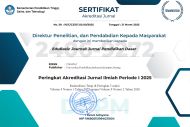Meta-Analysis of NHT and STAD Learning Models on Elementary School Students' Mathematical Cognitive Learning Outcomes
Abstract
Many studies showed the influence of the NHT and STAD learning models on the elementary school students’ mathematics learning outcomes. It is necessary to conduct a thorough re-analysis in a study to see how much influence the NHT and STAD learning models have on students’ mathematics learning outcomes with meta-analysis techniques. This study aims to determine the effect of the two learning models from various published experimental studies on mathematics learning outcomes. This study employed a meta-analysis method. The first step was to determine the problem, then searched the research articles' data on the internet through Google Scholar. The search results found 20 matching articles. The NHT learning model showed a mean increase of 82.31%, greater than the STAD learning model with 78.59%. The prerequisite test using the normality, homogeneity, and linearity tests revealed that the two learning models were normally distributed, homogeneous, and linear. The normality test utilizing the Shapiro-Wilk technique obtained a significance value of > 0.05. The pre-test data homogeneity test showed Sig. 0.081> 0.05, while the post-test data revealed Sig. 0.444 > 0.05. The linearity test of the two learning models uncovered a significance value of > 0.05. Besides, the ANCOVA test with univariate showed that the Partial Eta Squared value was 0.210, with Sig. 0.042 < 0.05, meaning that H0 was rejected, and Ha was accepted. The results showed that there were significant differences. Effect size calculation revealed that the NHT and STAD learning models had a relatively small effect on mathematics learning outcomes.
Keywords
Full Text:
PDFReferences
Aristyadharma, G. M. P., Putra, D. K. N. S., & Ardana I. M. (2014). Pengaruh model pembelajaran NHT berbantuan media kongkret terhadap hasil belajar IPA siswa kelas V gugus I Kuta, Badung tahun ajaran 2013/2014. Mimbar PGSD Universitas Pendiddikan Ganesha, 2(1), 1–8.
Fatoyah, S., Nayazik, A., & Wahyuni, A. (2020). Studi komparasi hasil belajar matematika menggunakan model pembelajaran kooperatif tipe Numbered Heads Together (NHT) dan Student Teams Achievement Division (STAD). Jurnal Ilmiah Pendidikan Matematika Al Qalasadi, 4(1), 50–55.
Gupitararas, B., & Wasitohadi, W. (2020). Pengaruh model Number Head Together (NHT) terhadap hasil belajar matematika siswa kelas IV SD. Jurnal Cendekia: Jurnal Pendidikan Matematika, 4(1), 313–320.
Halimah, N. (2017). Perbedaan pengaruh model Student Teams Achievement Division (STAD) dan Numbered Heads Together (NHT) terhadap hasil belajar matematika siswa kelas V SD. Scholaria: Jurnal Pendidikan dan Kebudayaan, 7(3), 267–275.
Ihsan, I. A., Muhajir, M., & Saputra, H. J. (2019). Keefektifan model pembelajaran Student Teams Achievement Division berbantu media puzzle terhadap keterampilan berbicara siswa. Jurnal Ilmiah Sekolah Dasar, 3(4), 489–496.
Indriastuti, N. (2016). Studi Komparasi Strategi Student Teams Achievement Division (STAD) dan Numbered Heads Together (NHT) terhadap Hasil Belajar Matematika Siswa Kelas IV SDN 1 Siswodipuran Boyolali Tahun Ajaran 2015/2016. (Unpublished Thesis). Surakarta: Universitas Muhammadiyah Surakarta.
Juraini, J., Taufik, M., & Gunada. I. W. (2016). Pengaruh model pembelajaran kooperatif tipe STAD (Student Team Achievement Division) dengan metode eksperimen terhadap keterampilan proses sains dan hasil belajar fisika pada siswa SMA Negeri 1 Labuapi tahun pelajaran 2015/2016. Jurnal Pendidikan Fisika dan Teknologi, 2(2), 80–85.
Kusumawati, H., & Mawardi, M. (2016). Perbedaan penerapan model pembelajaran kooperatif tipe NHT dan STAD ditinjau dari hasil belajar siswa. Scholaria: Jurnal Pendidikan dan Kebudayaan, 6(3), 251–263.
Natalia, N., Kristin, F. & Anugraheni, I. (2019). Perbedaan efektivitas model pembelajaran kooperatif tipe STAD dan NHT ditinjau dari hasil belajar ipa siswa kelas 4 SD Gugus Joko Tingkir. Vox Edukasi, 10(1), 1–11.
Ngaeni, E. N., & Saefudin, A. A. (2017). Menciptakan pembelajaran matematika yang efektif dalam pemecahan masalah matematika dengan model pembelajaran problem posing. Jurnal Aksioma, 6(2), 264–274.
Pradana, P. H. (2016) Pengaruh pembelajaran kooperatif tipe NHT & STAD dan motivasi belajar terhadap hasil belajar matematika. Jurnal Gammath, 1(2), 9–17.
Ridwanthi, K. D. P., Japa, I. G. N., & Agung, A. A. G. (2013). Pengaruh model pembelajaran kooperatif tipe NHT berbantuan media Question Cards terhadap hasil belajar matematika siswa kelas IV SDN 6 Bondalem. Mimbar PGSD Universitas Pendidikan Ganesha, 1(1), 1–10.
Sari, E. D. A. (2015). Pengaruh penerapan model kooperatif tipe NHT terhadap hasil belajar siswa pada mata pelajaran IPS kelas IV. Jurnal Penelitian PGSD, 3(2), 1–10.
Setiawan, Y., & Setyaningtyas, E. (2020). Perbedaan model pembelajaran Numberhead Together (NHT) dengan model pembelajaran Student Team Achievement Division (STAD) terhadap gaya belajar dan hasil belajar tematik siswa kelas IV sekolah dasar. Jurnal Ilmiah Wahana Pendidikan, 6(2), 133–141.
Susilowati, S., & Sumarjono, S. (2017). Keefektifan model pembelajaran STAD dan NHT ditinjau dari hasil belajar IPA. Jurnal Mitra Pendidikan, 1(6), 768–777.
Wardana, I., Banggali, T., & Husain, H. (2017). Penerapan model pembelajaran kooperatif tipe Student Team Achivement Division (STAD) untuk meningkatkan hasil belajar siswa kelas XI IPA Avogadro SMA Negeri 2 Pangkajene (Studi pada materi Asam Basa). Jurnal Chemica, 18(1), 76–84.
DOI: https://doi.org/10.17509/ebj.v3i1.33020
Refbacks
- There are currently no refbacks.
Copyright (c) 2021 Universitas Pendidikan Indonesia
This work is licensed under a Creative Commons Attribution 4.0 International License.
This journal is indexed by




.png)




.png)
1.png)


1.png)

.png)